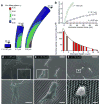Mechanical regulation of cell function with geometrically modulated elastomeric substrates
- PMID: 20676108
- PMCID: PMC3069358
- DOI: 10.1038/nmeth.1487
Mechanical regulation of cell function with geometrically modulated elastomeric substrates
Erratum in
- Nat Methods. 2011 Feb;8(2):184
Abstract
We report the establishment of a library of micromolded elastomeric micropost arrays to modulate substrate rigidity independently of effects on adhesive and other material surface properties. We demonstrated that micropost rigidity impacts cell morphology, focal adhesions, cytoskeletal contractility and stem cell differentiation. Furthermore, early changes in cytoskeletal contractility predicted later stem cell fate decisions in single cells.
Conflict of interest statement
The authors declared no competing interests.
Figures



Comment in
-
Stem cells feel the difference.Nat Methods. 2010 Sep;7(9):695-7. doi: 10.1038/nmeth0910-695. Nat Methods. 2010. PMID: 20805798 Free PMC article.
References
Publication types
MeSH terms
Substances
Grants and funding
LinkOut - more resources
Full Text Sources
Other Literature Sources

